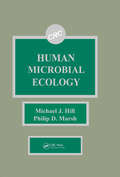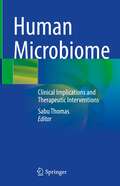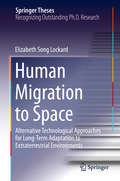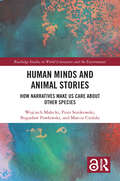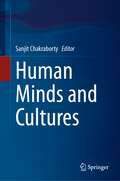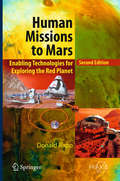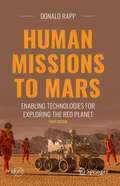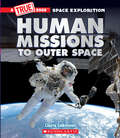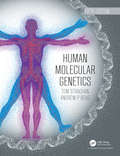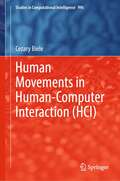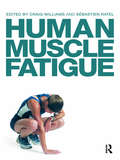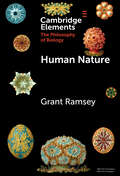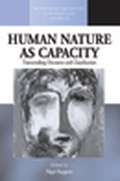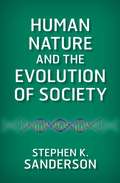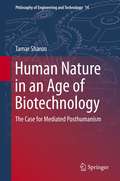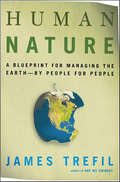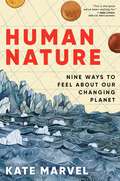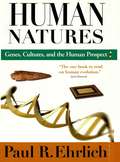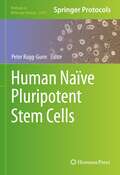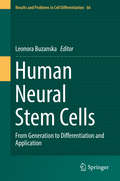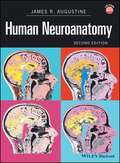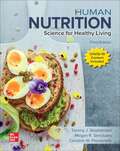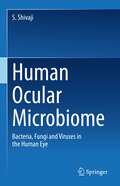- Table View
- List View
Human Microbial Ecology
by Michael J. Hill Philip D. MarshThe aim of this comprehensively written volume is to provide a baseline of information on the normal microflora at various sites in the body. It focuses on the mouth, upper digestive tract, large intestine, skin, and urinogenital tract. Written in an easy-to-read format, this book highlights the level of detail available. For example, it explains that in the mouth and colon the data are extremely detailed and good quantitative information is available on large numbers of bacterial species. This work analyzes the similarities and differences between the microfloras of the various "internal" surfaces, and discusses the clear value of good taxonomy. It focuses on problems and extended research in the progress at other sites. Because this work researches the advances and discoveries made in specific areas of human microbial ecology, it is an ideal source for all who are involved in microbiology, bacteriology, and infectious diseases.
Human Microbiome: Clinical Implications and Therapeutic Interventions
by Sabu ThomasThe human microbiome refers to the complete microorganisms inhabiting the human body sites including skin, ear, nose, oral cavity, the genital, gastrointestinal and respiratory tracts, and body fluids such as breast milk, saliva, and urine. It is a significant and essential organ recognized for the body and has an established involvement in the host wellbeing, in terms of nutritional requirements and immunomodulation. This book talks about how alteration and imbalance in the same can have clinical implications associated with a multitude of gastrointestinal, lifestyle-associated, and neurodegenerative disorders. How the proliferation of specific groups of bacteria and their metabolic activities, as a result of intestinal dysbiosis leads to the 'leaky gut' condition thereby influences brain activity via the bidirectional gut-brain axis. It also coves the importance of microbial seeding and how it can be influenced by the mode of delivery, nutrition, and medication. This book also provides various therapeutic interventions such as the establishment of stool banks and Faecal microbiota transplantation (FMT) that have recently proved promising in the treatment of ASD, Inflammatory Bowel Disease, and Ulcerative Colitis. This book provides a deeper understanding of the development of the human gut microbiome and the factors driving its dysbiosis. This book is a valuable read for health professionals, medical students, nutritionists, and scientific research communities who are eager to update themselves with recent trends in microbiome research. It will also aid gastroenterologists and nutritionists to make well-informed choices regarding therapeutic regimes.
Human Migration to Space
by Elizabeth Song LockardHuman migration to space will be the most profound catalyst for evolution in the history of humankind, yet this has had little impact on determining our strategies for this next phase of exploration. Habitation in space will require extensive technological interfaces between humans and their alien surroundings and how they are deployed will critically inform the processes of adaptation. As humans begin to spend longer durations in space--eventually establishing permanent outposts on other planets--the scope of technological design considerations must expand beyond the meager requirements for survival to include issues not only of comfort and well‐being, but also of engagement and negotiation with the new planetary environment that will be crucial to our longevity beyond Earth. Approaching this question from an interdisciplinary approach, this dissertation explores how the impact of interior space architecture can meet both the physical and psychological needs of future space colonists and set the stage for humankind to thrive and grow while setting down new roots beyond Earth.
Human Minds and Animal Stories: How Narratives Make Us Care About Other Species (Routledge Studies in World Literatures and the Environment)
by Wojciech Małecki Piotr Sorokowski Bogusław Pawłowski Marcin CieńskiThe power of stories to raise our concern for animals has been postulated throughout history by countless scholars, activists, and writers, including such greats as Thomas Hardy and Leo Tolstoy. This is the first book to investigate that power and explain the psychological and cultural mechanisms behind it. It does so by presenting the results of an experimental project that involved thousands of participants, texts representing various genres and national literatures, and the cooperation of an internationally-acclaimed bestselling author. Combining psychological research with insights from animal studies, ecocriticism and other fields in the environmental humanities, the book not only provides evidence that animal stories can make us care for other species, but also shows that their effects are more complex and fascinating than we have ever thought. In this way, the book makes a groundbreaking contribution to the study of relations between literature and the nonhuman world as well as to the study of how literature changes our minds and society. "As witnessed by novels like Black Beauty and Uncle Tom’s Cabin, a good story can move public opinion on contentious social issues. In Human Minds and Animal Stories a team of specialists in psychology, biology, and literature tells how they discovered the power of narratives to shift our views about the treatment of other species. Beautifully written and based on dozens of experiments with thousands of subjects, this book will appeal to animal advocates, researchers, and general readers looking for a compelling real-life detective story." - Hal Herzog, author of Some We Love, Some We Hate, Some We Eat : Why It’s So Hard To Think Straight About Animals
Human Minds and Cultures
by Sanjit ChakrabortyThis book puts forward a harmonious analysis of similarities and differences between two concepts—human minds and cultures—and strives for a multicultural spectrum of philosophical explorations that could assist them in pondering the striking pursuit of envisaging human minds and cultures as an essential appraisal of philosophy and the social sciences. The book hinges on a theoretical understanding of the indispensable liaison between the dichotomy of minds and objectivity residing in semantic-ontological conjectures. The ethnographic sense of cultures confines the scope of cultural scientism, an evolutionary paradigm on the functionalist turn, where one could enthral the cultural phenomenon from the contentment of the conflict of scientific quandaries. Hence, cultural relativism concedes that cultures have some descriptive contents, like customs, beliefs, moral codes, other minds, etc., that are followed by an individual or a group of people. However, the notion of societalsemiotics embarks on the ‘semiotic conception of culture’ that deploys modernity and values centred on ethical conjectures. Human Minds and Cultures conspicuously attune the cultural edifice of moral minds and cope with the enduring prospects of ethics, genders, laws, and socio-political affairs. Essential reading for anyone with a sparkling interest in human minds and cultures.
Human Missions to Mars
by Donald RappA mission to send humans to explore the surface of Mars has been the ultimate goal of planetary exploration since the 1950s, when von Braun conjectured a flotilla of 10 interplanetary vessels carrying a crew of at least 70 humans. Since then, more than 1,000 studies were carried out on human missions to Mars, but after 60 years of study, we remain in the early planning stages. The second edition of this book now includes an annotated history of Mars mission studies, with quantitative data wherever possible. Retained from the first edition, Donald Rapp looks at human missions to Mars from an engineering perspective. He divides the mission into a number of stages: Earth's surface to low-Earth orbit (LEO); departing from LEO toward Mars; Mars orbit insertion and entry, descent and landing; ascent from Mars; trans-Earth injection from Mars orbit and Earth return. For each segment, he analyzes requirements for candidate technologies. In this connection, he discusses the status and potential of a wide range of elements critical to a human Mars mission, including life support consumables, radiation effects and shielding, microgravity effects, abort options and mission safety, possible habitats on the Martian surface and aero-assisted orbit entry decent and landing. For any human mission to the Red Planet the possible utilization of any resources indigenous to Mars would be of great value and such possibilities, the use of indigenous resources is discussed at length. He also discusses the relationship of lunar exploratio n to Mars exploration. Detailed appendices describe the availability of solar energy on the Moon and Mars, and the potential for utilizing indigenous water on Mars. The second edition provides extensive updating and additions to the first edition, including many new figures and tables, and more than 70 new references, as of 2015.
Human Missions to Mars: Enabling Technologies for Exploring the Red Planet (Springer Praxis Books)
by Donald RappIn this book, Donald Rapp looks at human missions to Mars from a technological perspective. He divides the mission into a number of stages: Earth’s surface to low-Earth orbit (LEO); departing from LEO toward Mars; Mars orbit insertion and entry, descent and landing; ascent from Mars; trans-Earth injection from Mars orbit and Earth return.A mission to send humans to explore the surface of Mars has been the ultimate goal of planetary exploration since the 1950s, when von Braun conjectured a flotilla of 10 interplanetary vessels carrying a crew of at least 70 humans. Since then, more than 1,000 studies were carried out. This third edition provides extensive updating and additions to the last edition, including new sections, and many new figures and tables, and references.
Human Missions to Outer Space: A True Book: Space Exploration (A True Book (Relaunch))
by Laurie CalkhovenFrom the first time a person looked up at the sky and wondered “What’s out there?” humans have dreamed about exploring the cosmos.This book is part of a series A True Book: Space Exploration, that includes the titles Human Missions to Outer Space, Mars Rovers, The International Space Station, and UFO's. The series features the latest NASA imagery and lively text to bring the wonder of space exploration directly to readers.About 60 years ago, the first manned spacecraft left Earth’s atmosphere for the first time. In the years since, astronauts have visited the moon several times—and have spent extended time living in outer space. We even have plans to send humans to Mars by the 2030s! Share in the joy of exploration and discovery with Human Missions to Outer Space.
Human Molecular Genetics
by Tom Strachan Andrew ReadHuman Molecular Genetics has been carefully crafted over successive editions to provide an authoritative introduction to the molecular aspects of human genetics, genomics and cell biology.Maintaining the features that have made previous editions so popular, this fifth edition has been completely updated in line with the latest developments in the field. Older technologies such as cloning and hybridization have been merged and summarized, coverage of newer DNA sequencing technologies has been expanded, and powerful new gene editing and single-cell genomics technologies have been added. The coverage of GWAS, functional genomics, stem cells, and disease modeling has been expanded. Greater focus is given to inheritance and variation in the context of populations and on the role of epigenetics in gene regulation. Key features: Fully integrated approach to the molecular aspects of human genetics, genomics, and cell biology Accessible text is supported and enhanced throughout by superb artwork illustrating the key concepts and mechanisms Summary boxes at the end of each chapter provide clear learning points Annotated further reading helps readers navigate the wealth of additional information in this complex subject and provides direction for further study Reorganized into five sections for improved access to related topics Also new to this edition – brand new chapter on evolution and anthropology from the authors of the highly acclaimed Human Evolutionary Genetics A proven and popular textbook for upper-level undergraduates and graduate students, the new edition of Human Molecular Genetics remains the ‘go-to’ book for those studying human molecular genetics or genomics courses around the world.
Human Molecular Genetics (Human Molecular Genetics Ser.)
by Tom Strachan Andrew ReadHuman Molecular Genetics is an established and class-proven textbook for upper-level undergraduates and graduate students which provides an authoritative and integrated approach to the molecular aspects of human genetics. While maintaining the hallmark features of previous editions, the Fourth Edition has been completely updated. It includes new Key Concepts at the beginning of each chapter and annotated further reading at the conclusion of each chapter, to help readers navigate the wealth of information in this subject. The text has been restructured so genomic technologies are integrated throughout, and next generation sequencing is included. Genetic testing, screening, approaches to therapy, personalized medicine, and disease models have been brought together in one section. Coverage of cell biology including stem cells and cell therapy, studying gene function and structure, comparative genomics, model organisms, noncoding RNAs and their functions, and epigenetics have all been expanded.
Human Movements in Human-Computer Interaction (Studies in Computational Intelligence #996)
by Cezary BieleThis book discusses human–computer interaction (HCI) which is a multidisciplinary field of study which aims at developing and implementing tools and techniques to attain an effective and efficient interaction between the humans (the users) and computers. In recent years, there is an increase of interest of HCI researchers and practitioners in the inclusion of gaze gestures which can greatly enhance the communication between the human user and the computer, as well as other more “physical” communication involving all what can be learned from movements of the human body, from face, hand, leg, foot, etc., to the whole body movement, even extending to the involvement of groups of agents, even society. These explicitly human-centric issues in the development, design, analysis, and implementation of the HCI systems are discussed in the book. A comprehensive state of the art is given complemented with original own proposals. As opposed to more traditional formal and IT based analyses, the discussion is here more focused on relevant research results from psychology and psychophysiology, and other soft, cognitive, etc., sciences. Remarks on the relevance of affective computing are also mentioned.
Human Muscle Fatigue
by Craig A. WilliamsWhen human muscle fatigues, athletic performance becomes impaired. For those individuals suffering muscle or metabolic diseases the effects of muscle fatigue can make everyday tasks difficult. Understanding the scientific processes responsible for skeletal muscle fatigue is therefore central to the study of the physiology of sport, exercise and health. Written by a team of leading international exercise scientists, this book explores the mechanisms of muscle fatigue and presents a comprehensive survey of current research on this important topic. Examining the wide variety of protocols, assessment methods and exercise models used to study muscle fatigue, the book explores the differential effects of fatigue as influenced by: age gender fitness and training the use of ergogenic aids medical conditions including cerebral palsy, muscular dystrophy and glycogenosis. Human Muscle Fatigue covers both clinical and applied approaches in sport and exercise physiology and devotes an entire section to the conceptual framework underpinning research in this area, helping readers from a wide range of backgrounds to engage with the topic. Accessible and detailed, this book is a key text for students and practitioners working in exercise and sports science, medicine, physical therapy and health.
Human Nature (Elements in the Philosophy of Biology)
by Grant RamseyHuman nature is frequently evoked to characterize our species and describe how it differs from others. But how should we understand this concept? What is the nature of a species? Some take our nature to be an essence and argue that because humans lack an essence, they also lack a nature. Others argue for non-essentialist ways of understanding human nature, which usually aim to provide criteria for sorting human traits into one of two bins, the one belonging to our nature and the other outside our nature. This Element argues that both the essentialist and trait bin approaches are misguided. Instead, the author develops a trait cluster account of human nature, which holds that human nature is based on the distribution of our traits over our (actual and possible) life histories. One benefit of this account is that it aligns human nature with the human sciences, rendering the central concern of the human sciences to be the study of human nature. This title is also available as Open Access on Cambridge Core.
Human Nature As Capacity
by Nigel RapportWhat is it to be human? What are our specifically human attributes, our capacities and liabilities? Such questions gave birth to anthropology as an Enlightenment science. This book argues that it is again appropriate to bring "the human" to the fore, to reclaim the singularity of the word as central to the anthropological endeavor, not on the basis of the substance of a human nature - "To be human is to act like this and react like this, to feel this and want this" - but in terms of species-wide capacities: capabilities for action and imagination, liabilities for suffering and cruelty. The contributors approach "the human" with an awareness of these complexities and particularities, rendering this volume unique in its ability to build on anthropology's ethnographic expertise.
Human Nature and the Evolution of Society
by Stephen K. SandersonIf evolution has changed humans physically, has it also affected human behavior? Drawing on evolutionary psychology, sociobiology, and human behavioral ecology, Human Nature and the Evolution of Society explores the evolutionary dynamics underlying social life. In this introduction to human behavior and the organization of social life, Stephen K. Sanderson discusses traditional subjects like mating behavior, kinship, parenthood, status-seeking, and violence, as well as important topics seldom included in books of this type, especially gender, economies, politics, foodways, race and ethnicity, and the arts. Examples and research on a wide range of human societies, both industrial and nonindustrial, are integrated throughout. With chapter summaries of key points, thoughtful discussion questions, and important terms defined within the text, the result is a broad-ranging and comprehensive consideration of human society, thoroughly grounded in an evolutionary perspective.
Human Nature and the Evolution of Society
by Stephen K. SandersonIf evolution has changed humans physically, has it also affected human behavior? Drawing on evolutionary psychology, sociobiology, and human behavioral ecology, Human Nature and the Evolution of Society explores the evolutionary dynamics underlying social life. In this introduction to human behavior and the organization of social life, Stephen K. Sanderson discusses traditional subjects like mating behavior, kinship, parenthood, status-seeking, and violence, as well as important topics seldom included in books of this type, especially gender, economies, politics, foodways, race and ethnicity, and the arts. Examples and research on a wide range of human societies, both industrial and nonindustrial, are integrated throughout. With chapter summaries of key points, thoughtful discussion questions, and important terms defined within the text, the result is a broad-ranging and comprehensive consideration of human society, thoroughly grounded in an evolutionary perspective.
Human Nature in an Age of Biotechnology
by Tamar SharonNew biotechnologies have propelled the question of what it means to be human - or posthuman - to the forefront of societal and scientific consideration. This volume provides an accessible, critical overview of the main approaches in the debate on posthumanism, and argues that they do not adequately address the question of what it means to be human in an age of biotechnology. Not because they belong to rival political camps, but because they are grounded in a humanist ontology that presupposes a radical separation between human subjects and technological objects. The volume offers a comprehensive mapping of posthumanist discourse divided into four broad approaches--two humanist-based approaches: dystopic and liberal posthumanism, and two non-humanist approaches: radical and methodological posthumanism. The author compares and contrasts these models via an exploration of key issues, from human enhancement, to eugenics, to new configurations of biopower, questioning what role technology plays in defining the boundaries of the human, the subject and nature for each. Building on the contributions and limitations of radical and methodological posthumanism, the author develops a novel perspective, mediated posthumanism, that brings together insights in the philosophy of technology, the sociology of biomedicine, and Michel Foucault's work on ethical subject constitution. In this framework, technology is neither a neutral tool nor a force that alienates humanity from itself, but something that is always already part of the experience of being human, and subjectivity is viewed as an emergent property that is constantly being shaped and transformed by its engagements with biotechnologies. Mediated posthumanism becomes a tool for identifying novel ethical modes of human experience that are richer and more multifaceted than current posthumanist perspectives allow for. The book will be essential reading for students and scholars working on ethics and technology, philosophy of technology, poststructuralism, technology and the body, and medical ethics.
Human Nature: A Blueprint for Managing the Earth—by People, for People
by James TrefilA radical approach to the environment which argues that by harnessing the power of science for human benefit, we can have a healthier planetAs a prizewinning theoretical physicist and an outspoken advocate for scientific literacy, James Trefil has long been the public's guide to a better understanding of the world. In this provocative book, Trefil looks squarely at our environmental future and finds-contrary to popular wisdom-reason to celebrate. For too long, Trefil argues, humans have treated nature as something separate from themselves-pristine wilderness to be saved or material resources to be exploited. What we need instead is a scientific approach to the environment that embraces the human transformation of nature for our benefit. In Human Nature, Trefil exposes the benefits of genetically modified species, uncovers vital facts about droughts and global warming, and points to examples of environmental management where catering to humans reaps greater rewards than sheltering other species. By taking advantage of explosive advances in the sciences, we can fruitfully manage the planet, if we rise to the challenge. Like Rachel Carson's Silent Spring and Paul Ehrlich's Population Bomb, Human Nature promises to fundamentally alter the way we perceive our relationship to the Earth-but with optimism rather than alarm.
Human Nature: Nine Ways to Feel About Our Changing Planet
by Kate MarvelA captivating exploration of climate change that uses nine different emotions to better understand the science, history, and future of our evolving planetScientist Kate Marvel has seen the world end before, sometimes several times a day. In the computer models she uses to study climate change, it’s easy to simulate rising temperatures, catastrophic outcomes, and bleak futures. But climate change isn’t just happening in those models. It’s happening here, to the only good planet in the universe. It’s happening to us. And she has feelings about that. Human Nature is a deeply felt inquiry into our rapidly changing Earth. In each chapter, Marvel uses a different emotion to explore the science and stories behind climate change. As expected, there is anger, fear, and grief—but also wonder, hope, and love. With her singular voice, Marvel takes us on a soaring journey, one filled with mythology, physics, witchcraft, bad movies, volcanoes, Roman emperors, sequoia groves, and the many small miracles of nature we usually take for granted.Hopeful, heartbreaking, and surprisingly funny, Human Nature is a vital, wondrous exploration of how it feels to live in a changing world.Human Nature is a biography of the Earth in nine emotions:WonderAngerGuiltFearGriefSurprisePrideHopeLove
Human Natures: Genes, Cultures, and the Human Prospect
by Paul R. EhrlichThe Bell Curve, The Moral Animal, The Selfish Gene -- these and a host of other books and articles have made a seemingly overwhelming case that our genes determine our behavior. Now, in a new book that is sure to stir controversy, one of the world's leading evolutionary biologists shows why most of those claims of genetic destiny cannot be true, and explains how the arguments often stem from a fundamental misunderstanding of evolution itself."You can't change human nature," the saying goes. But you can, Stanford biologist Paul Ehrlich shows us in Human Natures, and in fact, evolution is the story of those changing natures. He makes a compelling case that "human nature" is not a single, unitary entity, but is as diverse as humanity itself, and that changes in culture and other environmental variations play as much of a role in human evolution as genetic changes. We simply don't have enough genes to specify behavior at the level that is often asserted.Never has knowledge of our evolutionary past been more important to our future. Developing intelligent strategies for antibiotic use, pest control, biodiversity protection -- and even for establishing more equitable social arrangements -- all depend on understanding evolution and how it works. Using personal anecdote, vivid example, and stimulating narrative, Ehrlich guides us through the thicket of controversies over what science can and cannot say about the influence of our evolutionary past on everything from race to religion, from sexual orientation to economic development.A major work of synthesis and scholarship, Human Natures gives us the fruit of a lifetime's thought and research on evolution and environment by a modern master of scientific understanding. Ehrlich's innovative vision lights the way to a fresh view of human nature and evolution, bringing insight and clarity to urgent questions of where we are as a species, and where we may be headed.
Human Naïve Pluripotent Stem Cells (Methods in Molecular Biology #2416)
by Peter Rugg-GunnThis volume provides readers with a comprehensive collection of methods to guide them on how to generate, characterize, and use naïve human pluripotent stem cells (hPSCs). The chapters in this book cover topics such as three predominant routes to generate naïve hPSC lines; methods to differentiate naïve hPSCs into specialized cell types; and techniques to characterize naïve hPSCs using key molecular landmarks that benchmark and quality control the cell lines. Written in the highly successful Methods in Molecular Biology series format, chapters include introductions to their respective topics, lists of the necessary materials and reagents, step-by-step, readily reproducible laboratory protocols, and tips on troubleshooting and avoiding known pitfalls. Cutting-edge and thorough, Human Naïve Pluripotent Stem Cells: Methods and Protocols is a valuable resource for novice and expert researchers who are looking to learn more or expand their research in this developing field.
Human Neural Stem Cells: From Generation to Differentiation and Application (Results and Problems in Cell Differentiation #66)
by Leonora BuzanskaThis book summarizes early pioneering achievements in the field of human neural stem cell (hNSC) research and combines them with the latest advances in stem cell technology, including reprogramming and gene editing. The powerful potential of hNSC to generate and repair the developing and adult CNS has been confirmed by numerous experimental in vitro and in vivo studies. The book presents methods for hNSC derivation and discusses the mechanisms underlying NSC in vitro fate decisions and their in vivo therapeutic mode of action.The long-standing dogma that the human central nervous system (CNS) lacks the ability to regenerate was refuted at the end of the 20th century, when evidence of the presence of neurogenic zones in the adult human brain was found. These neurogenic zones are home to human neural stem cells (hNSCs), which are capable of self-renewing and differentiating into neurons, astrocytes and oligodendrocytes. NSCs isolated from human CNS have a number of clinical advantages, especially the innate potential to differentiate into functional neural cells. Nevertheless, their full clinical exploitation has been hindered by limited access to the tissue and low expansion potential. The search for an alternative to CNS sources of autologous, therapeutically competent hNSCs was the driving force for the many studies proving the in vitro plasticity of different somatic stem cells to generate NSCs and their functional progeny. Now the era of induced pluripotent stem cells has opened entirely new opportunities to achieve research and therapeutic goals with the aid of hNSCs.
Human Neuroanatomy
by James R. AugustineHuman Neuroanatomy: An Introduction, 2nd Edition is a comprehensive overview of the anatomy of the human brain and spinal cord. The book is written at a level to be of use as a text for advanced students and a foundational reference for researchers, clinicians in the field. Building on the foundations of first edition, this revision looks to increase user-friendliness and clinical applicability through improved figures and the addition of illustrative case studies. Written by James R. Augustine, with decades of experience teaching and researching in the field, Human Neuroanatomy, authoritatively covers this fundamental area of study within the neurosciences.
Human Nutrition: Science for Healthy Living
by Tammy J. Stephenson Megan Sanctuary Caroline PasserrelloHuman Nutrition: Science for Healthy Living is an interesting, engaging, reliable, and evidence-based introductory textbook with a wide variety of features to promote active learning. A clinical emphasis appeals to all, but is of particular relevance to those studying nutrition, dietetics, or health science professions, including nursing. Real-life and clinical examples, statistics, and evidence from professional sources address current and controversial topics and support the key concepts of the science of nutrition.
Human Ocular Microbiome: Bacteria, Fungi and Viruses in the Human Eye
by S. ShivajiThis book provides an integrated review of the human ocular microbiome. It documents the discovery of ocular surface microbes by the conventional cultivable method and next generation sequencing technologies in both healthy and diseased (keratitis, uveitis, endophthalmitis, blepharitis, conjunctivitis etc.) eyes. The book further discusses the confounding factors that influence the microbiome, mycobiome and virome. The chapters cover niche-specificity with reference to skin, eyelid- margin, hands etc. It highlights the concept of core genera, dysbiosis and discriminating genera and covers the functional relevance of the dysbiotic microbiome, mycobiome and virome with respect to ocular diseases. The book includes topics on the relevance of molecular mechanisms, including quorum-sensing and mucin metabolism to ocular disorders, such as dry eye; and, microbiome-based therapies for treating of ocular disorders like vernal keratoconjunctivitis. The book is essential for microbiologists studying the human eye, ophthalmologists treating eye infection and trauma. It also caters to students of medical microbiology and medicine.
